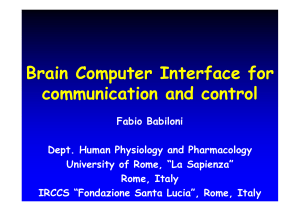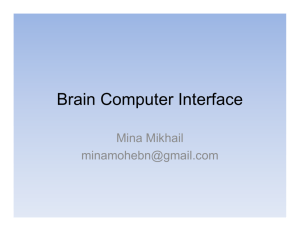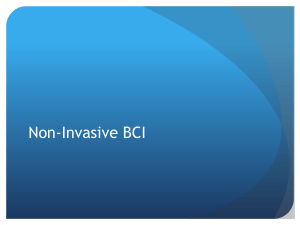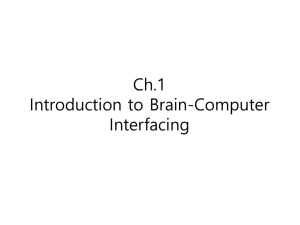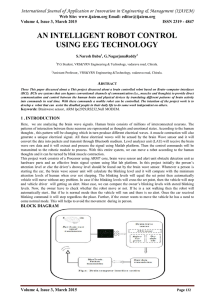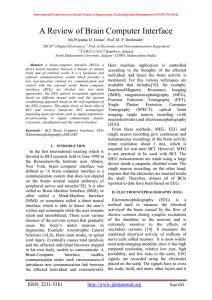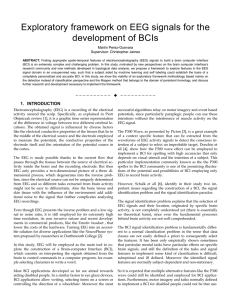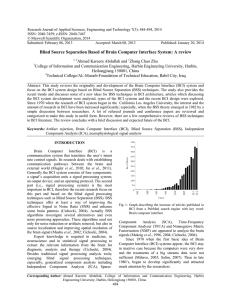NeuroLink: Thought Based Control of a Computer
advertisement
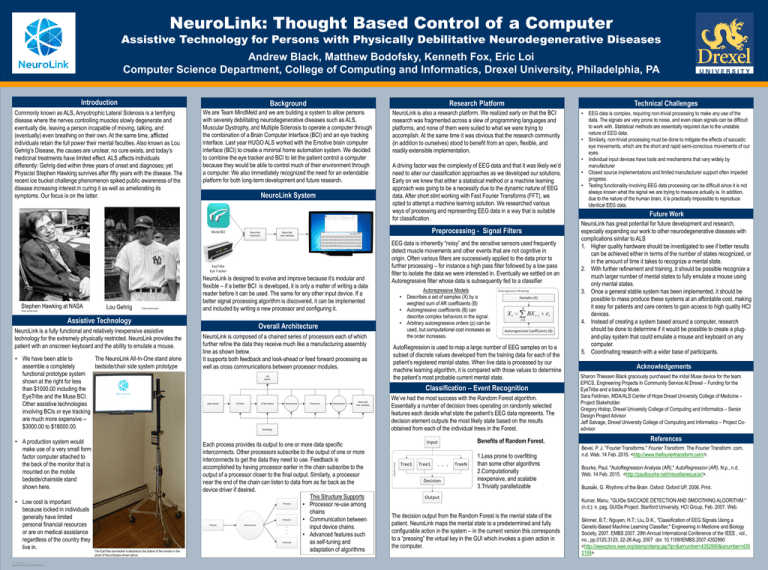
NeuroLink: Thought Based Control of a Computer Assistive Technology for Persons with Physically Debilitative Neurodegenerative Diseases Andrew Black, Matthew Bodofsky, Kenneth Fox, Eric Loi Computer Science Department, College of Computing and Informatics, Drexel University, Philadelphia, PA Introduction Commonly known as ALS, Amyotrophic Lateral Sclerosis is a terrifying disease where the nerves controlling muscles slowly degenerate and eventually die, leaving a person incapable of moving, talking, and (eventually) even breathing on their own. At the same time, afflicted individuals retain the full power their mental faculties. Also known as Lou Gehrig’s Disease, the causes are unclear, no cure exists, and today’s medicinal treatments have limited effect. ALS affects individuals differently: Gehrig died within three years of onset and diagnoses; yet Physicist Stephen Hawking survives after fifty years with the disease. The recent ice bucket challenge phenomenon spiked public awareness of the disease increasing interest in curing it as well as ameliorating its symptoms. Our focus is on the latter. Background We are Team MindMeld and we are building a system to allow persons with severely debilitating neurodegenerative diseases such as ALS, Muscular Dystrophy, and Multiple Sclerosis to operate a computer through the combination of a Brain Computer Interface (BCI) and an eye tracking interface. Last year HUGO ALS worked with the Emotive brain computer interface (BCI) to create a minimal home automation system. We decided to combine the eye tracker and BCI to let the patient control a computer because they would be able to control much of their environment through a computer. We also immediately recognized the need for an extendable platform for both long-term development and future research. NeuroLink System Research Platform NeuroLink is also a research platform. We realized early on that the BCI research was fragmented across a slew of programming languages and platforms, and none of them were suited to what we were trying to accomplish. At the same time it was obvious that the research community (in addition to ourselves) stood to benefit from an open, flexible, and readily extensible implementation. A driving factor was the complexity of EEG data and that it was likely we’d need to alter our classification approaches as we developed our solutions. Early on we knew that either a statistical method or a machine learning approach was going to be a necessity due to the dynamic nature of EEG data. After short stint working with Fast Fourier Transforms (FFT), we opted to attempt a machine learning solution. We researched various ways of processing and representing EEG data in a way that is suitable for classification. Preprocessing - Signal Filters Stephen Hawking at NASA Public domain photo Lou Gehrig Public domain photo Assistive Technology NeuroLink is a fully functional and relatively inexpensive assistive technology for the extremely physically restricted. NeuroLink provides the patient with an onscreen keyboard and the ability to emulate a mouse. • We have been able to The NeuroLink All-In-One stand alone assemble a completely bedside/chair side system prototype functional prototype system shown at the right for less than $1000.00 including the EyeTribe and the Muse BCI. Other assistive technologies involving BCIs or eye tracking are much more expensive -$3000.00 to $18000.00. • A production system would make use of a very small form factor computer attached to the back of the monitor that is mounted on the mobile bedside/chairside stand shown here. • Low cost is important because locked in individuals generally have limited personal financial resources or are on medical assistance regardless of the country they live in. TEMPLATE DESIGN © 2008 www.PosterPresentations.com The EyeTribe eye-tracker is attached to the bottom of the monitor in the photo of the prototype shown above. NeuroLink is designed to evolve and improve because it’s modular and flexible – if a better BCI is developed, it is only a matter of writing a data reader before it can be used. The same for any other input device. If a better signal processing algorithm is discovered, it can be implemented and included by writing a new processor and configuring it. Overall Architecture NeuroLink is composed of a chained series of processors each of which further refine the data they receive much like a manufacturing assembly line as shown below. It supports both feedback and look-ahead or feed forward processing as well as cross communications between processor modules. EEG data is inherently “noisy” and the sensitive sensors used frequently detect muscle movements and other events that are not cognitive in origin. Often various filters are successively applied to the data prior to further processing – for instance a high pass filter followed by a low pass filter to isolate the data we were interested in. Eventually we settled on an Autoregressive filter whose data is subsequently fed to a classifier Autoregressive Models • Describes a set of samples (X) by a weighted sum of AR coefficients (B) • Autoregressive coefficients (B) can describe complex behaviors in the signal. • Arbitrary autoregressive orders (p) can be used, but computational cost increases as the order increases. AutoRegression is used to map a large number of EEG samples on to a subset of discrete values developed from the training data for each of the patient’s registered mental states. When live data is processed by our machine learning algorithm, it is compared with those values to determine the patient’s most probable current mental state. Classification – Event Recognition We’ve had the most success with the Random Forest algorithm. Essentially a number of decision trees operating on randomly selected features each decide what state the patient’s EEG data represents. The decision element outputs the most likely state based on the results obtained from each of the individual trees in the Forest. Each process provides its output to one or more data specific interconnects. Other processors subscribe to the output of one or more interconnects to get the data they need to use. Feedback is accomplished by having processor earlier in the chain subscribe to the output of a processor closer to the final output. Similarly, a processor near the end of the chain can listen to data from as far back as the device driver if desired. This Structure Supports • Processor re-use among chains • Communication between input device chains. • Advanced features such as self-tuning and adaptation of algorithms Benefits of Random Forest. 1.Less prone to overfitting than some other algorithms 2.Computationally inexpensive, and scalable 3.Trivially parallelizable Technical Challenges • EEG data is complex, requiring non-trivial processing to make any use of the data. The signals are very prone to noise, and even clean signals can be difficult to work with. Statistical methods are essentially required due to the unstable nature of EEG data. • Similarly, non-trivial processing must be done to mitigate the effects of saccadic eye movements, which are the short and rapid semi-conscious movements of our eyes. • Individual input devices have tools and mechanisms that vary widely by manufacturer • Closed source implementations and limited manufacturer support often impeded progress. • Testing functionality involving EEG data processing can be difficult since it is not always known what the signal we are trying to measure actually is. In addition, due to the nature of the human brain, it is practically impossible to reproduce identical EEG data. Future Work NeuroLink has great potential for future development and research, especially expanding our work to other neurodegenerative diseases with complications similar to ALS 1. Higher quality hardware should be investigated to see if better results can be achieved either in terms of the number of states recognized, or in the amount of time it takes to recognize a mental state. 2. With further refinement and training, it should be possible recognize a much larger number of mental states to fully emulate a mouse using only mental states. 3. Once a general stable system has been implemented, it should be possible to mass produce these systems at an affordable cost, making it easy for patients and care centers to gain access to high quality HCI devices. 4. Instead of creating a system based around a computer, research should be done to determine if it would be possible to create a plugand-play system that could emulate a mouse and keyboard on any computer. 5. Coordinating research with a wider base of participants. Acknowledgements Sharon Thiessen Black graciously purchased the initial Muse device for the team. EPICS, Engineering Projects In Community Service At Drexel – Funding for the EyeTribe and a backup Muse. Sara Feldman, MDA/ALS Center of Hope Drexel University College of Medicine – Project Stakeholder Gregory Hislop, Drexel University College of Computing and Informatics – Senior Design Project Advisor Jeff Salvage, Drexel University College of Computing and Informatics – Project Coadvisor References Bevel, P. J. "Fourier Transforms." Fourier Transform. The Fourier Transform .com, n.d. Web. 14 Feb. 2015. <http://www.thefouriertransform.com/>. Bourke, Paul. "AutoRegression Analysis (AR)." AutoRegression (AR). N.p., n.d. Web. 14 Feb. 2015. <http://paulbourke.net/miscellaneous/ar/>. Buzsáki, G. Rhythms of the Brain. Oxford: Oxford UP, 2006. Print. Kumar, Manu. "GUIDe SACCADE DETECTION AND SMOOTHING ALGORITHM." (n.d.): n. pag. GUIDe Project. Stanford University, HCI Group, Feb. 2007. Web. The decision output from the Random Forest is the mental state of the patient. NeuroLink maps the mental state to a predetermined and fully configurable action in the system – in the current version this corresponds to a “pressing” the virtual key in the GUI which invokes a given action in the computer. Skinner, B.T.; Nguyen, H.T.; Liu, D.K., "Classification of EEG Signals Using a Genetic-Based Machine Learning Classifier," Engineering in Medicine and Biology Society, 2007. EMBS 2007. 29th Annual International Conference of the IEEE , vol., no., pp.3120,3123, 22-26 Aug. 2007 doi: 10.1109/IEMBS.2007.4352990 <http://ieeexplore.ieee.org/stamp/stamp.jsp?tp=&arnumber=4352990&isnumber=435 2185>

